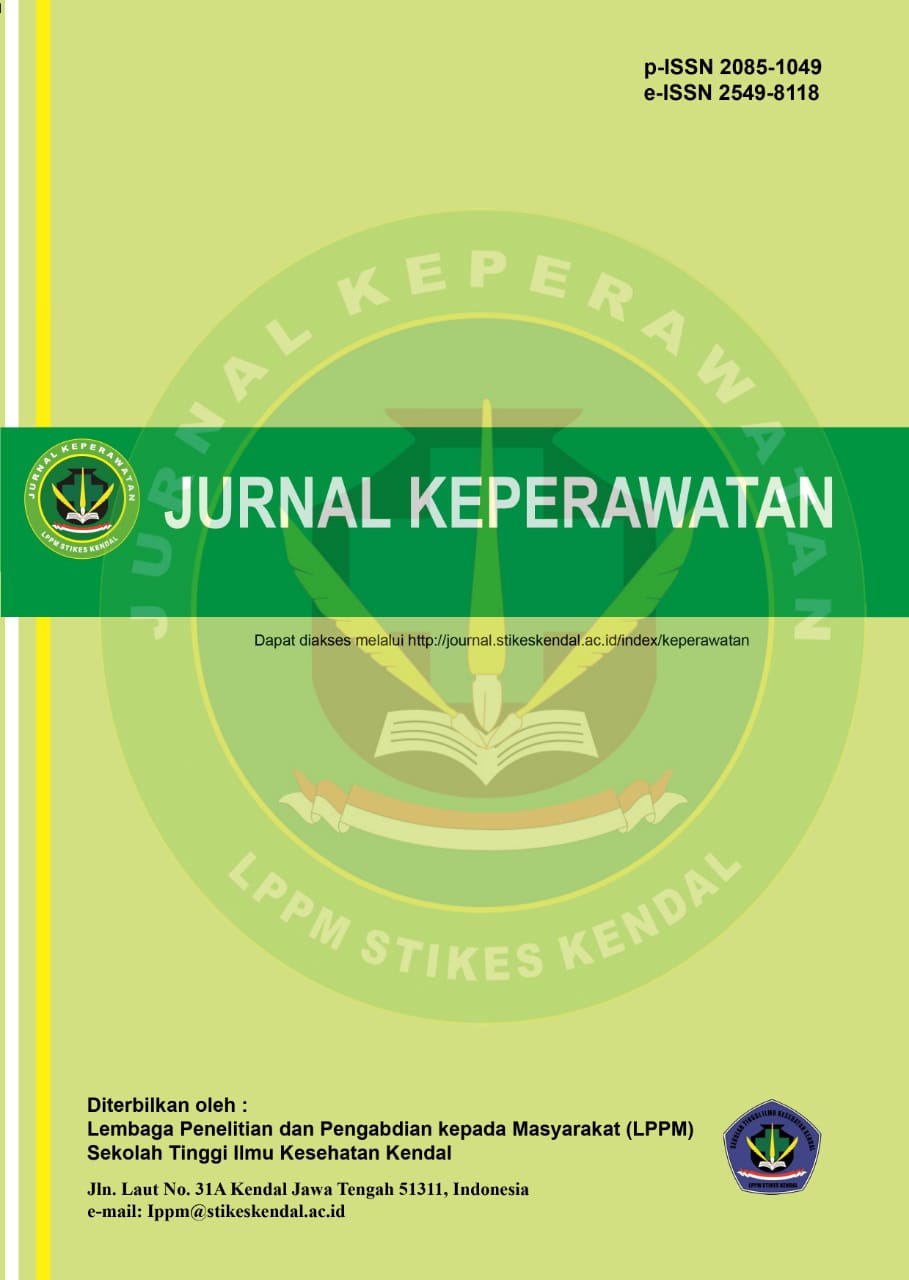Pengaruh Head of Bed (HOB) terhadap Kenyamanan Pasien dengan Nyeri Punggung Post Percutaneous Coronary Intervention: A Systematic Review
DOI:
https://doi.org/10.32583/keperawatan.v15i3.1047Keywords:
HOB, nyeri punggung, PCIAbstract
Keluhan rasa nyaman banyak terjadi pada pasien Post Percutaneous Coronary Intervention (PCI) karena setelah prosedur, pasien harus dibatasi di tempat tidur selama 6 sampai 12 jam. Pembatasan dan tirah baring untuk waktu yang lama terasa sulit dan berat bagi banyak pasien. Studi ini bertujuan untuk menganalisis penerapan Head of Bed (HOB) terhadap peningkatan kenyamanan pasien yang mengalami nyeri punggung post PCI. Database pencarian artikel didapatkan dari Pubmed, Science Direct, Google Scholar, Proquest, Scopus dan Klinikal Key dalam rentang waktu 2018-2023 dengan kata kunci istilah pencarian utama termasuk nyeri punggung, angiografi koroner, kateterisasi jantung, intervensi koroner perkutan, percutaneous coronary intervention, back pain, HOB, perubahan posisi. Kata kunci ini dicari secara terpisah atau digabungkan satu sama lain. Pencarian artikel disesuaikan dengan kriteria inklusi dan eksklusi selanjutnya dilakukan review. Berdasarkan telaah terhadap 9 artikel yang ditemukan, didapatkan hasil bahwa HOB dapat meningkatkan kenyamanan pasien yang mengalami nyeri punggung post PCI dengan cara menghambat perjalanan syaraf berdiameter kecil dalam menghantarkan rangsang nyeri. Kesimpulan dari studi di atas adalah penerapan HOB dapat meningkatkan kenyamanan pasien yang mengalami nyeri punggung post PCI.
References
Al-Hijji, M. A., Lennon, R. J., et al. (2019). Safety and risk of major complications with diagnostic cardiac catheterization. Circulation. Cardiovascular Interventions. Article E007791, 12(7). https://doi.org/https://doi.org/ 10.1161/circinterventions.119.007791.
Al-Momani, M. S., & AbuRuz, M. E. (2019). Incidence and predictors of groin complications early after coronary artery intervention: a prospective observational study. BMC Nursing, 18(24). https://doi.org/https://doi.org/10.1186/s12912-019-0349-8.
Amalia, S. R., Jayanti, A., & Mahendra, G. (2019). Teori Kenyamanan (Comfort) Kolcaba. POLTEKES KEMENKES Semarang.
Arafat, H., & Purwanti, D. (2020). Efektifitas Posisi dan Ambulasi Dini terhadap Nyeri Punggung pada Pasien Post Percutaneous Coronary Intervention. Medica Hospitalia, 7(1), 91–96. https://doi.org/https://doi.org/10.36408/mhjcm.v7i1.434.
Chaiyagad, C., Rattanakanokchai, S., Biostatistics, M. P. H., Suebkinorn, O., & Ruaisungnoen, W. (2023). Effects of a back-care bundle for reducing back pain among patients undergoing transfemoral artery coronary angiography: A randomized controlled trial. Applied Nursing Research, 69(October 2022), 151652. https://doi.org/10.1016/j.apnr.2022.151652.
Dharmadjati, B. (Staf D. K. dan K. vaskuler D. S. (2020). Intervensi Koroner Perkutan Primer pada Sindrom Koroner Akut. Promkes.Germas, 24(1), 8–11. https://rsudrsoetomo.jatimprov.go.id/wp-content/uploads/2021/01/rev5_Mimbar_vol-24-no-1.pdf.
Ebrahimi-Shalmani, F., Hasavari, F., Nikfarjam, S., Leili, E. K., & Javadi-Pashaki, N. (2020). The effect of the local cold application on low back pain and vascular complications of patients undergoing coronary angiography. International Journal of Research in Pharmaceutical Sciences, 11(4), 7754–7762. https://doi.org/10.26452/ijrps.v11i4.4220.
Elsaman, S. E. A. (2022). Association of position change and back massage and early ambulation with post-transfemoral coronary angiography complications. Journal of Vascular Nursing, 40(3), 128–133. https://doi.org/10.1016/j.jvn.2022.08.003.
Fereidouni, Z., Kameli Morandini, M., & Najafi Kalyani, M. (2019). The efficacy of interventions for back pain in patients after transfemoral coronary angiography: A rapid systematic review. Journal of Vascular Nursing, 37(1), 52–57. https://doi.org/10.1016/j.jvn.2018.11.002.
Gowshall M, T.-R. S. (2018). The increasing prevalence of noncommunicable diseases in low-middle income countries: the view from Malawi. Int J Gen Med, 11(255), 64. https://doi.org/https ://doi.org/10.2147/IJGM.S1579 87.
Ibdah, R. K., Ta’an, W. F., Shatnawi, R. M., Suliman, M. M., Rababah, J. A., & Rawashdeh, S. I. (2020). The effectiveness of early position change post cardiac catheterization on patient’s outcomes: A randomized controlled trial. Nursing Forum, 55(3), 380–388. https://doi.org/10.1111/nuf.12438.
Kristiyan, A., Purnomo, H. D., & Ropyanto, C. B. (2019). Pengaruh Kompres Dingin dalam Penurunan Nyeri Pasien Post Percutaneous Coronary Intervention ( PCI ) : Literature review. 2(1).
Lee, Y. K., Im, M., & Cho, H. (2022). An intervention study of a combined intervention of positioning and hand massage in patients undergoing radiofrequency catheter ablation. Nursing Open, May 2022, 1404–1414. https://doi.org/10.1002/nop2.1390.
Mert Boğa, S., & Öztekin, S. D. (2019). The effect of position change on vital signs, back pain and vascular complications following percutaneous coronary intervention. Journal of Clinical Nursing, 28(7–8), 1135–1147. https://doi.org/10.1111/jocn.14704.
Neishabouri, M., Haghighi, N., Gilvari, T., & Haghighat, S. (2020). Effect of changing position and early mobilization on back pain and vascular side effects in patients after coronary angiography. Journal of Nursing and Midwifery Sciences |, 7(1), 1–6. https://doi.org/10.4103/JNMS.JNMS.
Niveditha AS, P. D. (2019). Prevalence of heart disease among nonvegetarian individuals. Drug Invent Today, 12(6), 1250–3.
Oktaviono, Y. her (I. J. (2020). Tata laksana khusus intervensi koroner perkutan (B. (Staf D. K. dan K. vaskuler D. S. Dharmadjati (ed.)). Airlangga University Press.
Oktaviono, Y. her ( I. J. (2020). Komplikasi Pada Intervensi Koroner Perkutan. Airlangga University Press.
Reynolds, S., Waterhouse, K., & Miller, K. (2018). Head of bed elevation, early walking, and patient comfort after percutaneous transluminal coronary angioplasty. Dimensions of Critical Care Nursing, 20, 44–51. https://doi.org/https://doi.org/10.1097/00003465- 200105000-00013.
RI, Permenkes. (2021). Peringatan Hari Jantung Sedunia 2021: Jaga Jantungmu untuk Hidup Lebih Sehat.
Santos, V. B., Melo, L. M. e., Assis, A. R. V. de, Moraes, J. B. de, Lopes, C. T., Lopes, J. de L., & Barros, A. L. B. L. de. (2019). Decreasing length of limb immobilisation following nonelective transfemoral percutaneous coronary intervention: A randomised clinical trial. Journal of Clinical Nursing, 28(17–18), 3140–3148. https://doi.org/10.1111/jocn.14860.
Sarabi, H. N., Farsi, Z., Butler, S., & Pishgooie, A. H. (2021). Comparison of the effectiveness of position change for patients with pain and vascular complications after transfemoral coronary angiography: a randomized clinical trial. BMC Cardiovascular Disorders, 1–11. https://doi.org/10.1186/s12872-021-01922-w.
Türen, S., Yilmaz, R. A., Yesiltepe, N., & Bektas, I. (2022). Effect of the head of bed elevation on back pain after elective coronary angiography: A randomized controlled trial. Applied Nursing Research, 64. https://doi.org/10.1016/j.apnr.2022.151571.
Utami, T. F. C. T., Fatmasari, D., Mardiyono, & Shobirun. (2018). Effect of positioning on bleeding complication and low back pain after diagnostic coronary angiography in patients with coronary heart disease in an integrated heart care center in Indonesia. Belitung Nursing Journal, 4(2), 145–153. https://doi.org/10.33546/bnj.356.
Yıldız Ayvaz, M., Türen, S., ¨Oz Alkan, H., & Enç, N. (2019). Assessment of cardiovascular disease: Cardiac catheterization. In N. Enç (Ed.),. Cardiovascular Nursing, 42–47. https://doi.org/ISBN 978-605-335-457-4.
Downloads
Published
How to Cite
Issue
Section
License
Copyright (c) 2023 Jurnal Keperawatan

This work is licensed under a Creative Commons Attribution-NonCommercial-NoDerivatives 4.0 International License.




